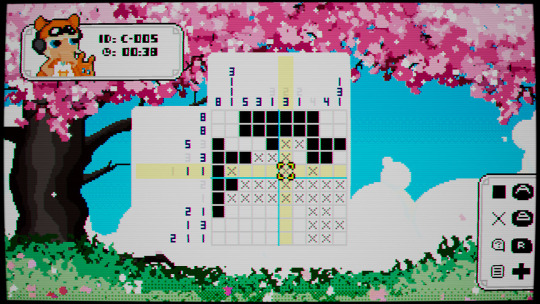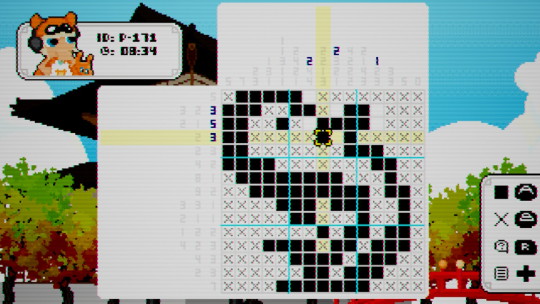#piczle cross adventure

I am a nonogram fanatic. I don’t know what exactly it is about the things, but I just can’t get enough of the little draw-by-numbers puzzles. Few games suck me in as intensely as a good Picross(or the indie equivalent).
In the past, I thought I was more-or-less alone in this. Nonogram games were few and far between. I even found myself hunting down ROMs of Picross games released for the Satellaview broadcast service for the Super Famicom just go get my fix! Now, on the Switch, there are so many nonogram games coming out that I have actually found myself falling slightly behind!
The latest twist are games that wed nonograms with a broader gameplay structure torn from another genre. The ingenious Murder by Numbers combined nonograms with a visual novel revolving around solving crimes. The recent PictoQuest merged nonograms with RPG mechanics. Now, we have Piczle Cross Adventure, which places the puzzles within a story-driven 2D adventure.

If you have never solved a nonogram puzzle before, let me explain the concept. You start with an empty grid. Each row and column of the grid has a series of numbers on it. Your goal is to fill the correct cells in the grid to create an image. You can think of it as a form of “paint-by-numbers”, where you need to identify the right spaces to mark for form a pixel-art painting.
The numbers on a row or a column tell you how many spots need to be filled in. If you see a “5″, you know that a five-block sequence will need to be filled, while blocks before and after those five will remain unfilled. To figure out which five need filled, you need to look at the corresponding columns (if you are working on a row) and see if you can match the conditions placed by the numbers on each of those. You will often see multiple numbers, like “2 3″, indicating that there are multiple sequences that will be filled in. In this case, the row would have a sequence of two filled-in blocks, then later, a second sequence of three filled-in blocks. At least one unfilled cell must exist between the two sequences. Again, you need to use the other clues to identify where the two sequences lie in the row.

That’s about all there is to it. Identify the spaces to fill, mark off those you know will not be filled, and try to complete the picture as fast as you can without making any mistakes. As pictures get larger, this becomes a tougher task. Even as a novice, you can probably complete 5x5 or 10x10 puzzles without breaking a sweat. As the puzzles grow, you may find it a little harder to keep track of everything. Still, try not to panic. A great thing about nonograms is that you should never have to make a blind guess. There is always enough information to unravel the next spot - it just may take some searching to identify it.
Piczle Cross Adventure presents its puzzles in a classic form, without additions like multiple colors or layers that have been used in other recent games. This is not a complaint, however, as the puzzles are well-designed. I’ve had a lot of fun chiseling my way through the game, and it has a lot of great little challenges in it. The primary enhancement on standard puzzles in Piczle Cross Adventure is that some larger pictures are broken up into a series of smaller puzzles. As you complete the individual small puzzles, you reveal that larger picture. In these cases, it may pay off to keep each surrounding piece in mind, as they will offer clues on where the borders of your current piece lie.

The most unique aspect of Piczle Cross Adventure is the inclusion of a massive overworld and story to guide your puzzle solving. The story revolves around the evil Mona Chromatic, who has unleashed the pixel-powered robot under_SCORE on the world in an attempt to rob it of its color. Score-chan, pet/companion(?) Gig, and Professor Matrix - the ostensible “protagonists” of the previous Piczle games - have set out to restore the zapped items and put the world together again.
This story is mainly a way to guide you from puzzle to puzzle. Each item is restored by completing a puzzle representing it. The overworld, presented in a 2D overhead Zelda-like manner, is broken up into a series of regions. Each region has a number of items to restore. Often, you will find that your progress is gated until you find a particular item from a different region. For instance, a fallen tree might block your progress in one direction until you restore a chainsaw in a different area and bring it back to clear the path.
Exploration of the overworld is not particularly deep. Other than unlocking items for simple puzzles, there isn’t a ton to do. You get XP for completing puzzles, but levelling up doesn’t really grant new abilities - beyond opening up more difficult puzzles. Still, it is a pretty compelling twist on the standard formula. Some puzzles are well-hidden, inside trash cans or behind trees. Hunting down every puzzle and filling in that section on your overworld map is an addictive process. The story and exploration give a nice feeling of progress as you work your way through.

As I mentioned, I played Piczle Cross Adventure on Switch. It is also available on Steam. I’d personally chose every time to play this kind of game on a portable system, so I’d recommend getting the Switch version. It looks nice on the tablet - though, I had to turn off the fake overscan. It also makes nice use of the HD rumble on the Switch. This is the kind of game that benefits from portability and being able to play a few puzzles in bed before you sleep.
Overall, I really enjoyed Piczle Cross Adventure. If you like nonogram puzzles, the ones in this game are really well designed. I also enjoyed exploring the overworld, trying to hunt down those last few obscure puzzles. If you’re looking for that next puzzle fix, this is definitely a game to look into.
A copy of Piczle Cross Adventure was provided for this review.
